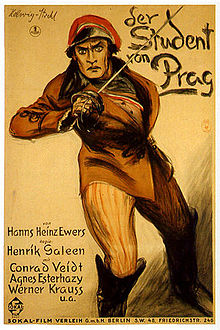- The Student of Prague (1926 film)
-
For other uses, see The Student of Prague.
The Student of Prague 
A 1926 promotional film posterDirected by Henrik Galeen Written by Hanns Heinz Ewers
Henrik GaleenStarring Conrad Veidt
Werner Krauss
Agnes EsterhazyCinematography Günther Krampf Release date(s) October 25, 1926 Country Germany Language Silent
German intertitlesThe Student of Prague (German: Der Student von Prag) is a 1926 silent film by actor and filmmaker Henrik Galeen. It is a remake of The Student of Prague (1913), directed by Stellan Rye. It is considered as Galeen's most important film since The Golem, which he co-directed in 1915 with Paul Wegener. In the meantime, Galeen had written the scripts for The Golem: How He Came Into the World (1920), Nosferatu (1922) and Waxworks (1924).
The film crew involved some famous names: Hermann Warm, who was one of the stage designers for The Cabinet of Dr. Caligari; Günther Krampf, cinematographer of The Hands of Orlac; and the actors Werner Krauss and Conrad Veidt, who already appeared together in Caligari and Waxworks.
For plot summery, see The Student of Prague (1913 film).
References
- Courtade, Francis (1984). Cinéma Expressionniste (1st ed. ed.). Paris: Henry Veyrier. ISBN 2-85199-334-9. (French)
External links
- Der Student von Prag (1926) at the Internet Movie Database
- The Student of Prague at AllRovi
Cinema of Germany 
Film chronology · German Empire 1895–1918 · Weimar Germany 1919–1933 · Nazi Germany 1933–1945 · East Germany (1945–1990) ·
(West) Germany 1945–present · 1945-1959 · 1960s · 1970s · 1980s · 1990s · 2000s · 2010s
Actors · Directors · Films A–Z · Cinematographers · Festivals · Producers · Composers · ScreenwritersCategories:- 1926 films
- 1920s horror films
- German Expressionist films
- Films of Weimar Germany
- Silent films
- Films set in Prague
- Silent film stubs
Wikimedia Foundation. 2010.
